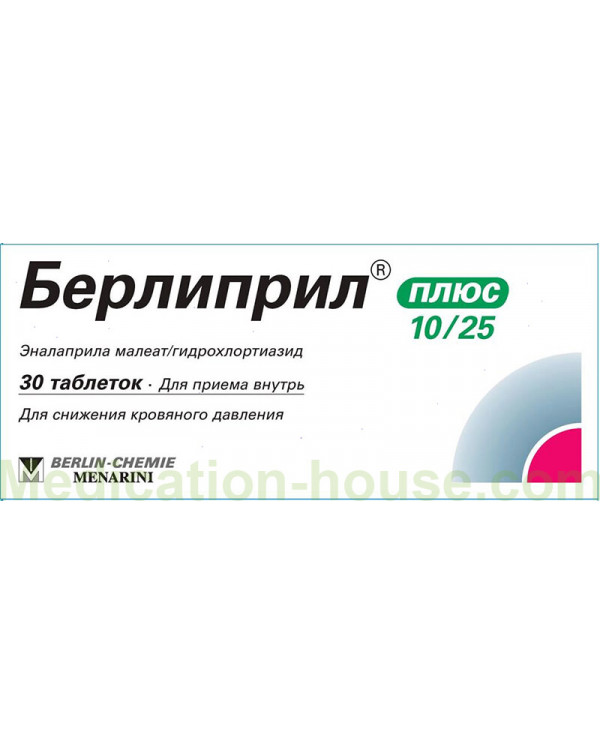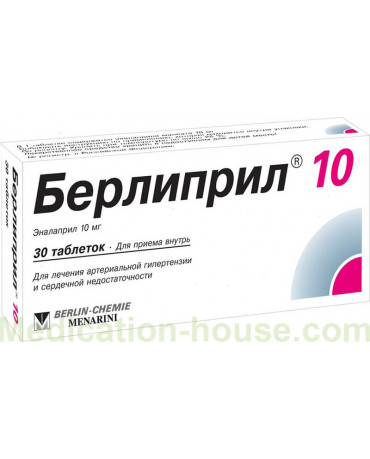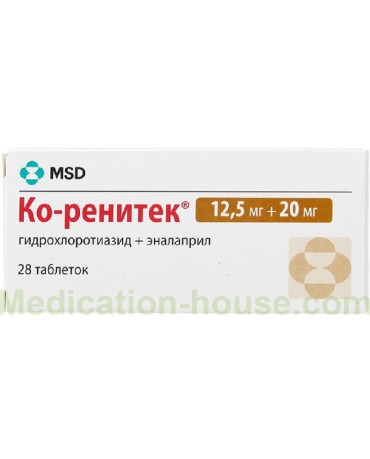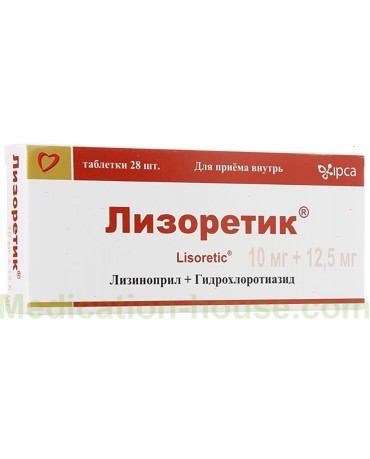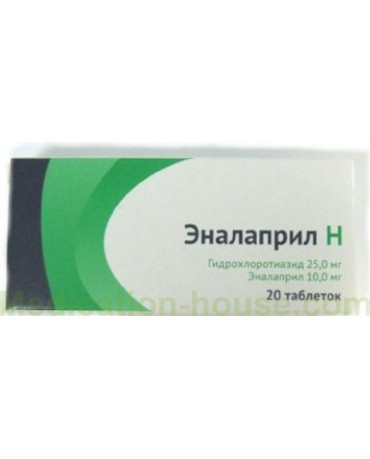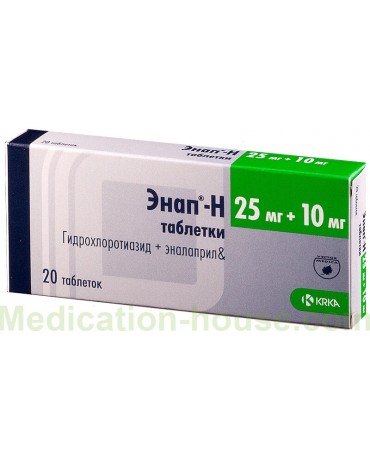Instruction for Berlipril Plus
Reed more and buy Berlipril Plus here
Release form and composition
The drug is produced in the form of tablets: light yellow, round, with chamfers and flat surfaces, a dividing line is applied on one side (10 pcs. In blisters of laminated film and aluminum foil, in a cardboard package 2, 3, 5 or 10 blisters and instructions for the use of Berlipril plus).
Composition for one tablet:
active substances: hydrochlorothiazide - 25 mg, enalapril (in the form of enalapril maleate) - 10 mg;
auxiliary components: colloidal silicon dioxide, magnesium carbonate, lactose monohydrate, magnesium stearate, sodium carboxymethyl starch (type A), gelatin, yellow iron oxide dye.
Pharmacodynamics
Berlipril plus is a combined agent that includes a thiazide diuretic (hydrochlorothiazide) and an ACE (angiotensin-converting enzyme) inhibitor (enalapril). These substances potentiate the effects of each other, and their antihypertensive action is cumulative.
Hydrochlorothiazide interferes with the reabsorption of water, chlorine and sodium in the kidney tubules. At the same time, it promotes the elimination of magnesium, potassium and bicarbonates, and also retains calcium ions. The diuretic effect occurs 2 hours after oral administration of the drug. The maximum effect is noted after 4 hours and lasts up to 12 hours inclusive. Hydrochlorothiazide reduces high blood pressure (blood pressure).
Enalapril inhibits ACE (the enzyme responsible for the conversion of angiotensin I to angiotensin II). Angiotensin II is a peptide with vasoconstrictor activity, therefore, when its formation slows down, the vasoconstrictor effect is weakened and the secretion of aldosterone decreases, and this, in turn, contributes to an increase in serum potassium concentration and the simultaneous excretion of fluid and sodium ions. By eliminating the negative reverse action of angiotensin II on renin production, plasma renin is activated. Enalapril lowers blood pressure by primary suppression of the activity of the RAAS (renin-angiotensin-aldosterone system). ACE is an enzyme identical to kininase II, which catalyzes the degradation of the peptide bradykinin, which has potential vasodilating activity. This allows enalapril to additionally realize its hypotensive effect.
When using enalapril in patients with hypertension, a decrease in blood pressure occurs both in the vertical and in the horizontal position of the patient (the heart rate increases slightly).
The combined administration of hydrochlorothiazide and enalapril can reduce the loss of potassium caused by a diuretic and prevent hypokalemia.
Pharmacokinetics
The combined use of a diuretic and an ACE inhibitor has practically no effect on the bioavailability of the active ingredients separately.
Hydrochlorothiazide
After taking Berlipril plus, about 60-80% of hydrochlorothiazide is absorbed into the systemic circulation. If the tablets are taken simultaneously with food, the absorption of the substance increases, since it depends on the duration of the movement of the intestinal contents. To reach the maximum plasma concentration of hydrochlorothiazide after taking a dose of 12.5 mg, it takes from 1.5 to 4 hours, after taking a dose of 25 mg - from 2 to 5 hours. The plasma concentration of the substance is linearly related to the dose taken, however, the relationship between the level of hydrochlorothiazide in the blood and the degree of blood pressure reduction has not been established.
Thiazides are widely distributed in liquids and almost completely (by 92%) bind to plasma proteins, including albumin. This explains the lower renal clearance (in comparison with the original forms of the substance) and a longer duration of action. The volume of distribution is 0.5-1.1 l / kg. The substance passes through the placenta to the fetus, but does not cross the blood-brain barrier.
More than 95% of hydrochlorothiazide is excreted unchanged (by the kidneys), since it is not metabolized in the body. In elderly patients and patients with impaired renal function, there is a significant decrease in the clearance of hydrochlorothiazide and a significant increase in its plasma concentration. Liver cirrhosis does not affect the pharmacokinetics of the substance.
Enalapril
Enalapril is a prodrug and exhibits its therapeutic properties in the form of an active metabolite - enalaprilat. After taking the drug inside, enalapril is completely absorbed from the gastrointestinal tract (gastrointestinal tract). Then it is almost completely converted into enalaprilat, the maximum serum concentration of which is reached 3-4 hours after taking Berlipril plus. The degree of absorption of the substance does not depend on food intake. Less than 50% of enalaprilat binds to plasma proteins.
The excretion of the active metabolite is carried out mainly by the kidneys. After oral administration of the drug, enalaprilat is excreted with an elimination half-life of about 11 hours. With impaired renal function, the elimination of the metabolite slows down.
Enalaprilat is removed from plasma by hemodialysis (the plasma concentration of the substance is reduced by about 46%) and peritoneal dialysis.
Indications for use
Berlipril plus is used to treat grade I – II essential hypertension in patients for whom enalapril monotherapy was insufficient or, if indicated, a combination therapy is recommended.
Contraindications
Absolute:
severe impairment of renal function (creatinine clearance is less than 30 ml / min);
the period after a recent kidney transplant (since there is no experience of using Berlipril plus);
stenosis of an artery of a single kidney or bilateral narrowing of the renal arteries (increased risk of renal failure);
severe liver dysfunction (from 9 points on the Child-Pugh scale);
myocardial infarction in patients who are being treated with hemo- or peritoneal dialysis (since the safety and efficacy of the drug have not been studied);
a history of indications of angioedema (including as a result of taking ACE inhibitors);
idiopathic and / or hereditary angioedema;
genetic lactose intolerance, lactase enzyme deficiency, glucose-galactose malabsorption (since the tablets include lactose);
children and adolescents up to 18 years old;
the period of pregnancy and breastfeeding;
hypersensitivity to the main or auxiliary components of the drug, as well as other ACE inhibitors and sulfonamide derivatives.
Relative (Berlipril plus is used with caution):
chronic renal failure (creatinine clearance value from 30 ml / min);
primary hyperaldosteronism (excess production of aldosterone);
simultaneous hemodialysis procedure;
mild and moderate liver dysfunctions (up to 9 points on the Child-Pugh scale);
a decrease in the volume of circulating blood (including as a result of vomiting or diarrhea);
violations of water and electrolyte balance;
narrowing of the aortic mouth, accompanied by a violation of hemodynamic parameters, as well as other reasons due to which the outflow of blood from the left ventricle slows down;
chronic heart failure;
coronary heart disease;
oppression of hematopoiesis in the bone marrow;
severe vascular diseases of the brain (including cerebral circulation insufficiency);
diabetes;
increased concentration of potassium in the blood (hyperkalemia);
a diet with a limited salt content;
severe systemic connective tissue diseases (scleroderma, systemic lupus erythematosus, etc.);
elderly age.
Berlipril plus, instructions for use: method and dosage
Berlipril Plus tablets should be taken orally with plenty of water or other liquid. Food intake does not affect the pharmacokinetic parameters of the drug.
The recommended dose for adults is 1 tablet once a day (in the morning).
At the beginning of treatment, symptomatic arterial hypotension may appear, which often occurs in patients with impaired water and electrolyte balance as a result of previous intake of diuretics. Diuretic drugs should be discontinued 2-3 days before starting treatment with Berlipril plus.
In patients over 65 years of age who do not have renal dysfunction (creatinine clearance is more than 90 ml / min), Berlipril plus is used in usual doses.
With a creatinine clearance of 30–80 ml / min, the use of a drug is possible only after the selection of doses of its components separately.
Side effects
digestive tract, liver and biliary tract: infrequently - vomiting, nausea, anorexia, dry mouth, indigestion, pancreatitis, abdominal pain, flatulence, diarrhea or constipation; isolated cases - intestinal obstruction, hepatitis; very rarely - angioedema of the intestine due to the intake of ACE inhibitors;
cardiovascular system: often - a significant decrease in blood pressure, regardless of the position of the patient's body; infrequently - heart rhythm disturbances, loss of consciousness; individual cases - palpitations, chest pain, tachycardia, angina pectoris, cerebrovascular accident, myocardial infarction, stroke;
respiratory system: often - cough (disappears after stopping therapy); infrequently - rhinitis, sinusitis, shortness of breath; isolated cases - stomatitis, bronchospasm, glossitis, interstitial pneumonia, pulmonary edema;
nervous system: often - systemic dizziness, headache, fatigue; infrequently - tinnitus, change in taste, increased excitability, impaired accommodation, paresthesia, insomnia or drowsiness, asthenia, confusion, depression;
musculoskeletal system: infrequently - muscle pain, muscle cramps;
genitourinary system: infrequently - renal failure, impaired potency, proteinuria, renal dysfunction, interstitial nephritis;
skin: infrequently - dry skin, rash, itching; rarely - hyperhidrosis, photosensitization, angioedema of the tongue, lips, larynx, glottis, face and / or extremities; very rarely - exudative erythema (including Stevens-Johnson syndrome);
laboratory tests: infrequently - hypokalemia, hypochloremia, hypomagnesemia, hyponatremia, hyperkalemia, hypercalcemia, hypercholesterolemia, hyperuricemia, hyperlipidemia, increased blood urea, serum creatinine and liver function tests, decreased hematocrit, decreased hemoglobin; rarely - an increase in the concentration of bilirubin and the activity of liver enzymes;
other reactions: gout, decreased sex drive, arthralgia.
Also, during therapy with ACE inhibitors, the following symptom complex is described: vasculitis, fever, eosinophilia, myositis / myalgia, serositis, leukocytosis, arthritis / arthralgia, increased erythrocyte sedimentation rate and a positive test for ANA (antinuclear antibodies).
Overdose
Symptoms of an overdose of Berlipril plus include: bradycardia, a significant decrease in blood pressure, renal failure, imbalance in water and electrolyte balance, stupor and shock. Most often, with hydrochlorothiazide intoxication, drowsiness and nausea appear. Excessive intake of hydrochlorothiazide leads to a loss of electrolytes (hypochloremia and hypokalemia occurs) and dehydration (due to increased urine output). The patient develops muscle cramps (as a result of hypokalemia), and if taken together with antiarrhythmic drugs and cardiac glycosides, the course of arrhythmia may worsen.
In case of an overdose of Berlipril plus, symptomatic and supportive treatment is prescribed. Strict monitoring of the patient's condition is required, preferably in inpatient conditions, including in the intensive care unit. Serum creatinine and electrolytes should be monitored regularly.
Therapeutic measures depend on the severity and nature of the symptoms. In the first 30 minutes, measures are taken to prevent further absorption of the drug from the gastrointestinal tract (the patient is washed with the stomach, given intestinal sorbents and sodium sulfate). With a significant drop in blood pressure, the patient should be laid down in a horizontal position with slightly raised legs. It is also necessary to resolve the issue of using drugs that increase the volume of circulating blood (intravenous infusion of isotonic sodium chloride solution). Perhaps the introduction of angiotensin II. Severe vagal reactions and bradycardia are eliminated by atropine; sometimes a pacemaker is used.
Enalaprilat is removed from the systemic circulation using hemodialysis; ACE inhibitors are also amenable to hemodialysis, but the use of high-flow polyacrylonitrile membranes should be avoided.
Special instructions
Enalapril
During treatment with the drug, especially at the beginning of therapy, it is necessary to regularly monitor the patient's condition. Consideration should be given to the likelihood of symptomatic arterial hypotension in patients with severe renal impairment, severe chronic heart failure, water-electrolyte disturbances (due to vomiting, diarrhea, adherence to a low-salt diet, prior diuretic treatment) or in patients on hemodialysis. In persons with severe vascular diseases of the brain, ischemic heart disease, narrowing of the aortic orifice, or other obstructions to the outflow of blood from the left ventricle with a significant drop in blood pressure, stroke and / or myocardial infarction are possible.
Severe hypotension with severe consequences is rare and usually transient. It is not a contraindication to continuing therapy with enalapril.
In rare cases, during treatment with ACE inhibitors, a syndrome appears that begins with cholestatic jaundice and progresses to sudden liver necrosis, sometimes fatal. The mechanism of occurrence and course of this syndrome is currently unclear. If jaundice appears or a pronounced increase in the activity of liver enzymes during the period of treatment with ACE inhibitors, they should be canceled and an additional examination of the patient should be carried out.
It is recommended to discontinue diuretics used before the appointment of Berlipril plus 2-3 days before the start of therapy, since the risk of arterial hypotension is high. Before and during treatment, it is necessary to monitor renal function (determine the level of protein in the urine), since proteinuria can appear in patients with impaired renal function and in patients who take relatively large doses of ACE inhibitors.
Patients receiving insulin or oral hypoglycemic drugs should be monitored, especially during the first month of therapy. In such patients, it is necessary to regularly determine the level of glucose in the blood.
Berlipril plus may increase serum potassium, especially in patients with diabetes mellitus, chronic renal failure, and when used together with potassium supplements, potassium-sparing diuretics, potassium salt substitutes and other drugs that increase serum potassium concentration (for example, with heparin ). This effect can be weakened by thiazide diuretics, which actively remove potassium. If the simultaneous administration of the above agents is necessary, it is recommended to regularly monitor the level of potassium in the serum.
ACE inhibitors increase the likelihood of neutropenia, especially in patients with reduced renal function, in particular, with concomitant connective tissue diseases or therapy with allopurinol, procainamide, immunosuppressants, and also in the case of a combination of several risk factors. Individual situations have been recorded when a patient developed a severe infectious disease, and there was no response to intensive antibiotic therapy. In such patients, it is recommended before starting treatment with enalapril, every 2 weeks during the first three months of therapy, and then regularly monitor the leukocyte count and do a detailed blood test. The patient should inform the doctor about the occurrence of any signs of infectious diseases (fever, sore throat), since in these cases the leukocyte blood count is necessarily determined. If reversible neutropenia is detected or if it is suspected, the drug should be discontinued, like other drugs taken simultaneously with it.
Before planned surgical interventions, it is necessary to inform the anesthesiologist about taking Berlipril plus, since the risk of arterial hypotension increases during operations under general anesthesia. If withdrawal of ACE inhibitors is not possible, the volume of circulating blood should be monitored.
Hemodialysis and other types of blood filtration using high-flow polyacrylonitrile membranes can lead to the development of anaphylactoid reactions; therefore, it is recommended to use other variants of membrane structures or to use alternative antihypertensive treatment with the appointment of drugs from other pharmacotherapeutic groups.
During desensitizing therapy to bee or wasp venom, people receiving ACE inhibitors may develop life-threatening hypersensitivity reactions. To avoid such reactions, before starting each session of such therapy, it is necessary to temporarily stop treatment with enalapril.
With angioedema of the face, lips and neck, Berlipril plus should be urgently canceled and continued treatment with another antihypertensive agent. In very rare cases, severe edema involving the glottis, larynx or tongue may not occur at the beginning of therapy, but after prolonged use of ACE inhibitors, which is life-threatening and can be fatal. It is recommended to take emergency measures, consisting in the immediate subcutaneous administration of 0.3-0.5 ml of epinephrine solution diluted in a ratio of 1: 1000 or slow intravenous administration of epinephrine 1 mg / ml under close monitoring of blood pressure and electrocardiogram. Requires hospitalization of the patient and monitoring of his condition within 12-24 hours.
Hydrochlorothiazide
In kidney disease, thiazide diuretics can worsen azotemia. In case of progression of renal failure (characterized by an increase in the total nitrogen content in the blood without an increase in protein nitrogen), it is necessary to resolve the issue with the abolition of Berlipril plus.
Plasma electrolyte levels should be systematically monitored, since thiazides can cause water-electrolyte disturbances (hyponatremia, hypokalemia and hypochloremic alkalosis). The main precursors of such conditions: thirst, dry mouth, nausea, vomiting, weakness, drowsiness, cramps, pain or weakness in the muscles, tachycardia, stupor, arterial hypotension, anxiety, oliguria.
Thiazide diuretics can cause hypokalemia, but concomitant use of enalapril helps to reduce this effect. The likelihood of hypokalemia increases in patients with increased diuresis, cirrhosis of the liver, as well as when combined with corticotropin or glucocorticosteroids and in the case of insufficient intake of table salt. In patients with edema in hot weather, dilution hyponatremia may appear. Chloride deficiency is usually mild and does not require special treatment.
Hydrochlorothiazide can reduce the excretion of calcium by the kidneys and increase the serum calcium concentration without any visible disturbances in its metabolism. One of the signs of latent hyperparathyroidism is severe hypercalcemia. Thiazide diuretics should be discontinued before determining the function of the parathyroid gland.
Thiazides can cause impaired glucose tolerance, therefore, in diabetic patients taking oral hypoglycemic agents or insulin, dosage adjustment of these drugs may be required. The manifestation of latent diabetes mellitus is possible.
Hydrochlorothiazide can increase the concentration of triglycerides and cholesterol, as well as exacerbate the course of a disease such as gout.
Professional athletes should take into account that the drug may result in a positive doping test result.
Influence on the ability to drive vehicles and complex mechanisms
During treatment with Berlipril plus, care must be taken when driving a car and performing other work that requires a high concentration of attention and quick psychomotor reactions.
Application during pregnancy and lactation
In pregnant women, the use of the drug is not recommended. When planning pregnancy, as well as in the event of its occurrence during the period of therapy with Berlipril plus, treatment should be stopped as early as possible. In the second and third trimesters of pregnancy, ACE inhibitors can cause diseases or death of the developing fetus / newborn, since drugs in this group can cause renal failure, increased blood pressure, hypoplasia of the skull bones and / or hyperkalemia. Due to impaired renal function in the fetus, it is possible to develop oligohydramnios, which can cause deformation of the bones of the skull, contracture of the extremities and underdevelopment of the lungs.
Pregnant women are not advised to take diuretics, as they can cause thrombocytopenia, jaundice and other adverse reactions common to adults in the newborn and fetus.
The patient should be warned of the possible risk to the fetus, and in cases where Berlipril plus is considered necessary, an ultrasound scan should be performed periodically to assess the amniotic fluid. Newborns whose mothers took the drug should be carefully examined for oliguria, hyperkalemia and arterial hypertension. To remove enalapril from the blood of a newborn, peritoneal dialysis is recommended. In theory, an ACE inhibitor can be removed by exchange transfusion.
Thiazide diuretics and enalapril are secreted in breast milk, therefore, breastfeeding should be suspended during treatment with the drug. Thiazides reduce or suppress lactation, cause hypokalemia and increase sensitivity to sulfonamide derivatives.
Childhood use
Berlipril plus is contraindicated for use in children and adolescents under 18 years of age, since there are no data on its safety and efficacy in childhood and adolescence.
With impaired renal function
Berlipril plus is not prescribed to patients with severe renal impairment. In chronic renal failure and in patients on hemodialysis, it is used with extreme caution.
For violations of liver function
Severe liver dysfunction is an absolute contraindication to taking Berlipril plus. For mild and moderate liver dysfunctions, the drug is used with caution.
Use in the elderly
In elderly patients, thiazide diuretics in combination with ACE inhibitors are prescribed with caution.
Drug interactions
Drug interactions due to the content of Berlipril plus enalapril in the composition:
potassium-containing salts, potassium supplements, potassium-sparing diuretics (amiloride, triamterene, spironolactone): hyperkalemia may develop (this combination is not recommended);
loop or thiazide diuretics: in the case of previous therapy with the listed drugs, at the beginning of treatment with enalapril, the volume of circulating blood may decrease and arterial hypotension may occur;
tricyclic antidepressants, barbiturates, narcotic drugs, psychotropic drugs: orthostatic hypotension may develop;
cimetidine: increased risk of collapse;
medicines for general anesthesia: worsening of orthostatic hypotension is possible;
cyclosporine: the likelihood of impaired renal function increases;
other antihypertensive agents (blockers of slow calcium channels, beta-blockers, alpha-blockers): it is possible to add or potentiate the hypotensive action;
hypoglycemic drugs: in rare cases, an increase in the hypoglycemic properties of insulin or oral hypoglycemic drugs may be observed (their dose may need to be adjusted);
procainamide, allopurinol, immunosuppressants and cytostatics: the likelihood of hypersensitivity reactions and leukopenia increases;
antacids: reduce the bioavailability of enalapril;
sympathomimetics: it is possible to weaken the hypotensive effect of Berlipril plus;
sodium aurothiomalate (gold preparation) in injectable form: arterial hypotension, nausea and flushing of the face may occur.
Drug interactions due to the content of Berlipril plus hydrochlorothiazide in the composition:
colestipol, cholestyramine: absorption of the drug in the gastrointestinal tract decreases;
corticotropin, carbenoxolone, amphotericin B (for intravenous administration), glucocorticosteroids, stimulating type laxanthins: possible increased loss of electrolytes (in particular, hypokalemia);
calcium salts: serum calcium concentration may increase;
vasoconstrictor amines (epinephrine): a slight decrease in the response to the introduction of epinephrine is possible;
non-depolarizing muscle relaxants (tubocurarine chloride): sensitivity to muscle relaxants may increase;
anti-gout agents (sulfinpyrazone, probenecid, allopurinol): an increase in the serum concentration of uric acid under the influence of hydrochlorothiazide is likely, which may require a dose adjustment of the listed funds;
cardiac glycosides: may increase arrhythmias due to hypomagnesemia or hypokalemia caused by thiazide diuretics;
amantadine: the likelihood of side reactions of amantadine increases.
Other types of drug interactions Berlipril plus:
lithium preparations: the risk of lithium intoxication increases (this combination is not recommended, or the serum concentration of lithium must be carefully monitored);
non-steroidal anti-inflammatory drugs: it is possible to weaken the hypotensive effect of the drug; the likelihood of impaired renal function increases;
ethanol: the hypotensive effect of Berlipril plus is enhanced;
trimethoprim: the risk of hypercalcemia increases.
Terms and conditions of storage
Keep out of the reach of children at a temperature not exceeding 30 ° C.
The shelf life of the drug is 3 years.
Reviews about Berlipril plus
There are relatively few reviews of Berlipril plus. Patients note a quick effect, convenient administration (one tablet per day), and a low cost of the drug. The drug reduces high blood pressure well.
The disadvantages, according to users, include a large number of contraindications and side effects, as well as the presence of Berlipril plus a diuretic effect.
Terms of sell
You can buy Berlipril Plus without a prescription from a doctor.

